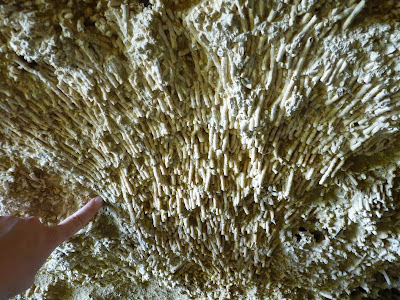Last week was my latest field trip, this time to Southern
Italy (with one of my supervisors) to look for samples of Pleistocene-Holocene
marine fossils, mostly interested in the coral Cladocora caespitosa, in the
uplifted marine terraces exposed around the coastline.
The marine terraces in
the south of Italy are uplifted thanks to the tectonics of the Mediterranean region
with various uplift rates in different areas thanks to the complex interplay
between regional and local tectonic regimes in this highly active region. The
country is squashed by the growth of the Apennines thrust belt to the east and
stretched by the Tyrrhenian back-arc basin to the west due to the westward
subduction and eastwards roll-back and delamination of the Adriatic-Ionian
plate. The delaminating lithosphere under the south of Italy further increases
the rate of uplift as dense material is removed from its base, causing the slab
to ‘float’ higher on the mantle (see Ferranti et al, 2006 for a nice overview).
Because of this expansive marine (and fluvial) terraces spanning numerous ages
are accessible along the coast, increasing in age with height gained, going
completely against the normal rules of stratigraphy.
 |
| Where we went |
After months of planning and trawling the available
literature to find localities where uplifted sediments and C. caespitosa had
been found previously I thought it would be easy to find these sites and get
plenty of samples. However it turned out that this really wasn’t the case; we
spent hours driving around just finding massive amounts of fluvial
conglomerates or getting to a supposed locality and finding that someone had
put a housing development there since the paper reference was written. When we
did find a locality it really was a case of grabbing as many samples as
possible to make up for the difficulty, often risking life & limb – such as
dangling off an unconsolidated cliff face, directly above a train track – to
get the best ones.
 |
| Le Castille on the Capo Rizzuto peninsula, actually has corals in the stones they used to build it, didn't think it was a good idea to sample them |
Although probably too old for the samples to be much use,
the most amazing locality I’ve seen yet was the ‘Coral cave’ above the village
of Tarsia. Although undated, judging by the elevation (~225m) and the level of
preservation of the fossils it looks like this outcrop may date back to MIS 11 (~400kyr
old). This location was studied by Bernasconi et al, 1997, and directions to the
site were kindly provided by her, she even visited the site to check it was
still accessible for us. As you can see in the photographs the cave is cut
right into a C. caespitosa reef so the walls and roof of the cave are almost
completely made up of massive, branching corals (conditions were obviously
perfect for growth at this time). What
made the site even more impressive were the thousands of burrowing sand bees
that are living in the sandy layer that the reef had established itself on,
these were a little worrying at first but they seemed harmless and completely
untroubled by our presence.
 |
| Tarsia 'Coral cave' |
 |
| Massive C. caespitosa colony found in cave |
While we had issues with the science, the trip made up for
that with amazing food and weather. The worryingly forecast regular heavy
storms failed to materialise (the one time it rained we were in the middle of a
long drive) and we saw 30oC pretty much every day. This was very
lucky as I’d failed to check that the tent I had borrowed for the trip actually
had tent pegs and guy lines in it. Had to improvise with whatever I found lying
around the campsite with sharpened twigs, rocks and a bent cutlery set all
being used on different nights. I don’t think any of these would have stood up
to much bad weather though. The amazing weather did have its downsides however,
trying to work on beaches looking in full field kit while surrounded by bikini
clad Italians is surprisingly off-putting.
 |
| Tent held up with cutlery AND rocks! |
On the food, we
mostly ate in the Italian equivalents of service station/truck stop
restaurants. However, while in this country you have to deal with a terrible
fast food burger or overpriced Ginsters, there (for around the same price) it
was amazing shellfish risottos, pasta and some of the best pizza I’ve ever
eaten (and I’ve eaten a lot of pizza), all
with very good locally produced wines. Truck drivers are very well catered for
in the south of Italy, as well as this amazing food, even in the middle of the
day all the laybys along the main roads are full of prostitutes, which does
make working on roadside exposures pretty unpleasant.
One worrying moment of the trip was, after spending hours of
searching, finding out that the one open campsite around the area of Isola di
Capo Rizzuto was naturist only. Luckily, it not being the tourist season they
were desperate for custom and allowed us to stay with our clothes on for a
night and the other few occupants were also thankfully dressed (nudists are NEVER
the kind of people you want to see without their clothes). Unfortunately, this
campsite, like most of the other sites we visited, was inhabited by incredibly noisy
nocturnal birds, they make a sound like a sonar which is impossible to sleep
through.
All in all it was a good (if intense) week, I’m still
knackered now almost a week later but that may have most to do with the shear
amount of catching up and post-trip sorting out I’m in the middle of than the
fieldwork itself. Now, where to go next...

No comments:
Post a Comment